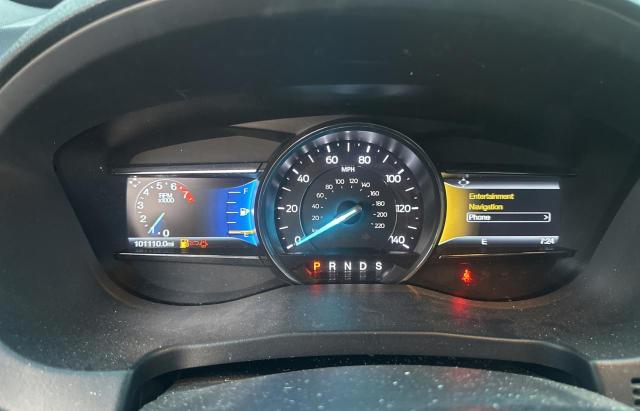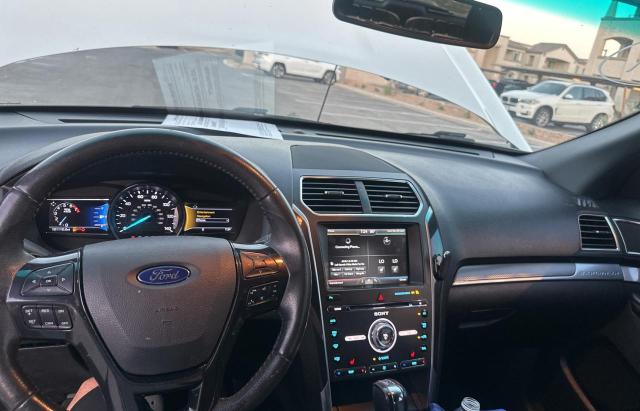2016 FORD EXPLORER | 1FM5K8GT0GGB18920
 ❯
❯
Specifications
4
~$50,000
Engine: 3.5L twin-turbocharged V6
Torque: 475 Nm
0–100 km/h: ~6.0 s
In its fifth generation, the Ford Explorer evolved from a body-on-frame SUV into a unibody crossover, dramatically enhancing its road performance and comfort. The top-performing Sport model featured a 3.5L twin-turbocharged EcoBoost V6 delivering 365 horsepower and 475 Nm of torque. Paired with a 6-speed automatic transmission and standard intelligent 4WD, it achieved 0–100 km/h acceleration in just 6.0 seconds — an impressive feat for a seven-passenger SUV.
The Explorer Sport distinguished itself with stiffer springs, a retuned steering rack, and larger brakes, allowing it to handle tighter curves and highway sweepers with more confidence than its base or XLT siblings. Despite its size, the Sport exhibited surprising composure in spirited driving, aided by torque-vectoring AWD and firmer damping. Body roll was well-managed, and road isolation remained solid thanks to a robust chassis tuned for family-friendly refinement with a hint of performance character.
This generation of Explorer struck a balance between power, space, and daily comfort, offering something few in its class could match. It sat between traditional three-row crossovers like the Honda Pilot and more athletic midsize SUVs, offering premium-like dynamics in Platinum and Sport trims. The EcoBoost V6 gave it legitimate muscle, while its ride quality, interior space, and technology features made it a compelling all-around family performance SUV.
Body Styles
The Ford Explorer was offered exclusively as a five-door, three-row midsize SUV riding on a unibody platform. With a wide, tall, and sculpted silhouette, it combined SUV stance with crossover aerodynamics. The design included a high beltline, gently arched roof, and a bold front fascia that varied by trim — especially the gloss black accents and dual exhausts on Sport and Platinum variants. The long wheelbase allowed for spacious third-row access and cargo capacity, while short overhangs and large wheel arches gave it a balanced, athletic profile. The rear quarter windows wrapped into the D-pillars, a design cue that emphasized forward motion and cabin lightness.
Model Name Meaning (Manufacturer)
Ford named the model “Explorer” to evoke the spirit of discovery and adventure. First introduced in 1990 as a response to growing interest in SUVs, the name was chosen to reflect a lifestyle of travel, exploration, and capability — aligning with the brand’s vision of the vehicle as a go-anywhere family hauler with trail-ready potential.
Model Name Meaning (Languages)
The word “Explorer” is a common English noun meaning one who investigates unknown regions or undertakes journeys of discovery. It carries connotations of boldness, curiosity, and mobility — ideal traits for an SUV. The name resonates internationally due to its clarity and positive associations, making it both aspirational and approachable for a wide range of markets.
Body & Interior Colors and Rims
Throughout this generation, the Ford Explorer offered a mix of neutral and expressive exterior colors including Oxford White, Magnetic Metallic, Ingot Silver, Ruby Red, Blue Jeans Metallic, and White Platinum Tricoat. The Sport trim introduced unique finishes such as Shadow Black with blacked-out grille, mirror caps, and roof rails, while the Platinum trim added satin chrome accents and exclusive paints like Burgundy Velvet.
Inside, color themes ranged from basic Ebony cloth to luxurious Nirvana leather in Ebony, Ceramic, or Medium Soft Ceramic hues. The Limited, Sport, and Platinum trims offered multi-contour leather seats with contrast stitching, perforation, and optional cooling or massage functions. Interior trim options included real aluminum, glossy black, faux wood, or satin-finish bezels, depending on trim level. The dashboard featured a clean, horizontal layout with a dual-cowl theme and integrated SYNC infotainment system.
Wheels started at 18 inches in basic models, moving to 20-inch machined aluminum or polished alloys in higher trims. Sport and Platinum trims featured exclusive 20- or 21-inch wheels with dark inserts, Y-spoke patterns, or dual-finish treatments. These larger wheels added visual weight and improved handling feel without significantly compromising ride quality.
Top Expensive Options
- 3.5L EcoBoost V6 Engine (Sport): $2,200
- Dual-Panel Moonroof: $1,595
- Active Park Assist with Front Sensors: $900
- Sony Premium Audio System (12 speakers): $995
- 20-inch Premium Polished Wheels: $1,295
- PowerFold Third Row Seats: $745
- Enhanced Active Safety Package (Lane Keep, Collision Warning): $1,200
- Multicontour Front Seats with Massage: $650
- Adaptive Cruise Control with Forward Collision Mitigation: $1,150
- Premium Nirvana Leather Interior (Platinum): $2,000
vs Competitors
Compared to rivals like the Honda Pilot, Toyota Highlander, and Chevrolet Traverse, the Ford Explorer offered the most performance-focused configuration in its Sport variant. While the Highlander and Pilot emphasized refinement and family ergonomics, the Explorer injected excitement with a twin-turbo V6 and dynamic design. Against the Traverse, it held the edge in drivetrain power and premium-level trim offerings but trailed slightly in third-row comfort and cargo layout. Luxury-brand competitors like the Acura MDX and Infiniti QX60 provided more finesse, but the Explorer matched or exceeded their power while undercutting them in price. Its strongest suit was versatility — offering a rugged look, premium features, and real muscle in one cohesive package.
Fun Fact
The Ford Explorer Sport was developed with direct input from Ford’s performance team, borrowing engineering practices from the Taurus SHO and F-150 Raptor projects. In fact, its 3.5L EcoBoost V6 shared core architecture with Ford’s performance sedans, making it one of the first mainstream three-row SUVs to emphasize both family utility and turbocharged acceleration — helping pave the way for today’s performance crossover trend.
Lot Details
-
Sale Date19/Jun/2025
-
Lot Number61109675
-
Sale document
-
Location
-
Odometer101,110 miles (162,720 km)
-
Primary Damage:NORMAL WEAR
-
Fuel
-
Engine Type3.5L 6
-
Transmission
-
Drive Type
-
Color
Final Bid Ford Explorer (2016)
$11,450
$11,450
$11,450
Specifications
4
~$50,000
Torque:
0–100 km/h:
In its fifth generation, the Ford Explorer evolved from a body-on-frame SUV into a unibody crossover, dramatically enhancing its road performance and comfort. The top-performing Sport model featured a 3.5L twin-turbocharged EcoBoost V6 delivering 365 horsepower and 475 Nm of torque. Paired with a 6-speed automatic transmission and standard intelligent 4WD, it achieved 0–100 km/h acceleration in just 6.0 seconds — an impressive feat for a seven-passenger SUV.
The Explorer Sport distinguished itself with stiffer springs, a retuned steering rack, and larger brakes, allowing it to handle tighter curves and highway sweepers with more confidence than its base or XLT siblings. Despite its size, the Sport exhibited surprising composure in spirited driving, aided by torque-vectoring AWD and firmer damping. Body roll was well-managed, and road isolation remained solid thanks to a robust chassis tuned for family-friendly refinement with a hint of performance character.
This generation of Explorer struck a balance between power, space, and daily comfort, offering something few in its class could match. It sat between traditional three-row crossovers like the Honda Pilot and more athletic midsize SUVs, offering premium-like dynamics in Platinum and Sport trims. The EcoBoost V6 gave it legitimate muscle, while its ride quality, interior space, and technology features made it a compelling all-around family performance SUV.
Body Styles
The Ford Explorer was offered exclusively as a five-door, three-row midsize SUV riding on a unibody platform. With a wide, tall, and sculpted silhouette, it combined SUV stance with crossover aerodynamics. The design included a high beltline, gently arched roof, and a bold front fascia that varied by trim — especially the gloss black accents and dual exhausts on Sport and Platinum variants. The long wheelbase allowed for spacious third-row access and cargo capacity, while short overhangs and large wheel arches gave it a balanced, athletic profile. The rear quarter windows wrapped into the D-pillars, a design cue that emphasized forward motion and cabin lightness.
Model Name Meaning (Manufacturer)
Ford named the model “Explorer” to evoke the spirit of discovery and adventure. First introduced in 1990 as a response to growing interest in SUVs, the name was chosen to reflect a lifestyle of travel, exploration, and capability — aligning with the brand’s vision of the vehicle as a go-anywhere family hauler with trail-ready potential.
Model Name Meaning (Languages)
The word “Explorer” is a common English noun meaning one who investigates unknown regions or undertakes journeys of discovery. It carries connotations of boldness, curiosity, and mobility — ideal traits for an SUV. The name resonates internationally due to its clarity and positive associations, making it both aspirational and approachable for a wide range of markets.
Body & Interior Colors and Rims
Throughout this generation, the Ford Explorer offered a mix of neutral and expressive exterior colors including Oxford White, Magnetic Metallic, Ingot Silver, Ruby Red, Blue Jeans Metallic, and White Platinum Tricoat. The Sport trim introduced unique finishes such as Shadow Black with blacked-out grille, mirror caps, and roof rails, while the Platinum trim added satin chrome accents and exclusive paints like Burgundy Velvet.
Inside, color themes ranged from basic Ebony cloth to luxurious Nirvana leather in Ebony, Ceramic, or Medium Soft Ceramic hues. The Limited, Sport, and Platinum trims offered multi-contour leather seats with contrast stitching, perforation, and optional cooling or massage functions. Interior trim options included real aluminum, glossy black, faux wood, or satin-finish bezels, depending on trim level. The dashboard featured a clean, horizontal layout with a dual-cowl theme and integrated SYNC infotainment system.
Wheels started at 18 inches in basic models, moving to 20-inch machined aluminum or polished alloys in higher trims. Sport and Platinum trims featured exclusive 20- or 21-inch wheels with dark inserts, Y-spoke patterns, or dual-finish treatments. These larger wheels added visual weight and improved handling feel without significantly compromising ride quality.
Top Expensive Options
- 3.5L EcoBoost V6 Engine (Sport): $2,200
- Dual-Panel Moonroof: $1,595
- Active Park Assist with Front Sensors: $900
- Sony Premium Audio System (12 speakers): $995
- 20-inch Premium Polished Wheels: $1,295
- PowerFold Third Row Seats: $745
- Enhanced Active Safety Package (Lane Keep, Collision Warning): $1,200
- Multicontour Front Seats with Massage: $650
- Adaptive Cruise Control with Forward Collision Mitigation: $1,150
- Premium Nirvana Leather Interior (Platinum): $2,000
vs Competitors
Compared to rivals like the Honda Pilot, Toyota Highlander, and Chevrolet Traverse, the Ford Explorer offered the most performance-focused configuration in its Sport variant. While the Highlander and Pilot emphasized refinement and family ergonomics, the Explorer injected excitement with a twin-turbo V6 and dynamic design. Against the Traverse, it held the edge in drivetrain power and premium-level trim offerings but trailed slightly in third-row comfort and cargo layout. Luxury-brand competitors like the Acura MDX and Infiniti QX60 provided more finesse, but the Explorer matched or exceeded their power while undercutting them in price. Its strongest suit was versatility — offering a rugged look, premium features, and real muscle in one cohesive package.
Fun Fact
The Ford Explorer Sport was developed with direct input from Ford’s performance team, borrowing engineering practices from the Taurus SHO and F-150 Raptor projects. In fact, its 3.5L EcoBoost V6 shared core architecture with Ford’s performance sedans, making it one of the first mainstream three-row SUVs to emphasize both family utility and turbocharged acceleration — helping pave the way for today’s performance crossover trend.









